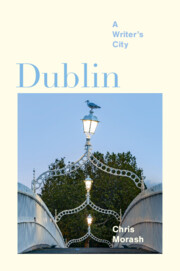Book contents
- Dublin
- Imagining Cities
- Dublin
- Copyright page
- Dedication
- Contents
- A Writer’s City: Series Preface
- Chronology
- Additional material
- Introduction The Imagined City in Time of Pandemic
- 1 Mapping the City
- 2 Baggotonia
- 3 Around St. Stephen’s Green
- 4 Trinity College
- 5 Around the Liberties
- 6 O’Connell Street and the Abbey Theatre
- 7 The North Inner City
- 8 South Dublin
- 9 The South Coast
- 10 North Dublin
- 11 Riverrun
- Read On …
- Notes
- Bibliography
- Acknowledgements
- Index
- Plate Section
10 - North Dublin
Published online by Cambridge University Press: 16 February 2023
- Dublin
- Imagining Cities
- Dublin
- Copyright page
- Dedication
- Contents
- A Writer’s City: Series Preface
- Chronology
- Additional material
- Introduction The Imagined City in Time of Pandemic
- 1 Mapping the City
- 2 Baggotonia
- 3 Around St. Stephen’s Green
- 4 Trinity College
- 5 Around the Liberties
- 6 O’Connell Street and the Abbey Theatre
- 7 The North Inner City
- 8 South Dublin
- 9 The South Coast
- 10 North Dublin
- 11 Riverrun
- Read On …
- Notes
- Bibliography
- Acknowledgements
- Index
- Plate Section
Summary
Where the inner suburbs of south Dublin were Victorian, most of the development on the north side of the city has taken place in the twentieth century, so that historical layers – Georgian, Victorian, twentieth-century, and contemporary – sit adjacent to one another. Anne Enright’s Booker Prize-winning novel, The Gathering, makes use of this stratified cityscape, but it figures elsewhere, as well, including in recent crime fiction. As we move towards the old docklands in the north city, we find ourselves in a completely new cityscape, which is beginning to be explored by writers such as Paul Murray, while the older neighbourhoods nearby have been the territory of Conor McPherson’s plays; it was here, too, that Bram Stoker was born. However, the real challenge for contemporary Irish writing has been to invest the new largely working-class suburbs of north Dublin with the same kind of dense cultural associations as the historic city centre.The central figures here have been Paula Meehan, Dermot Bolger, and Roddy Doyle, whose fictional Barrytown is based on Kilbarrack where he grew up. Finally, at the limits of the city, we come to Howth, where Joyce’s Ulysses reaches its conclusion.
- Type
- Chapter
- Information
- DublinA Writer's City, pp. 208 - 229Publisher: Cambridge University PressPrint publication year: 2023

